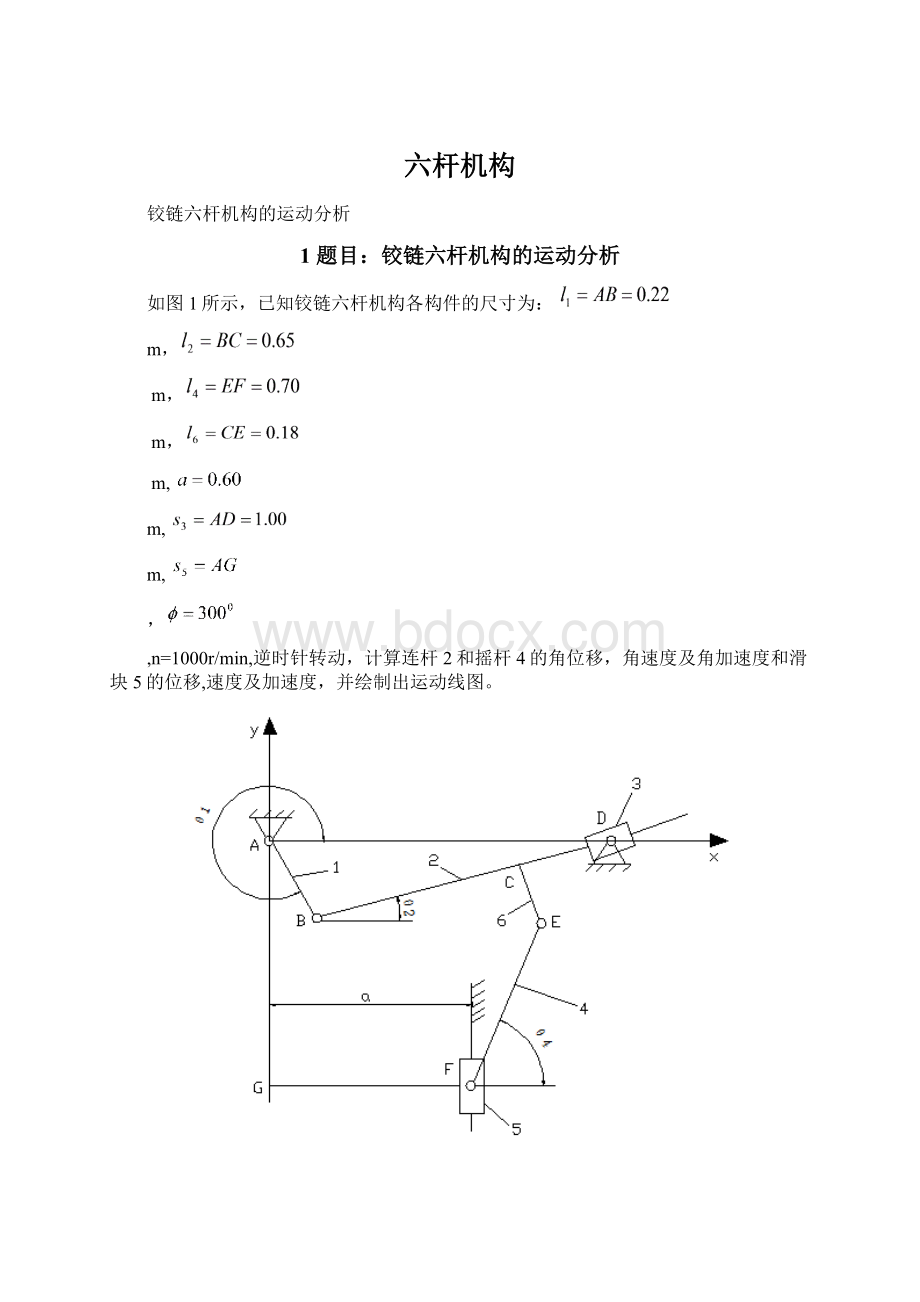六杆机构Word下载.docx
《六杆机构Word下载.docx》由会员分享,可在线阅读,更多相关《六杆机构Word下载.docx(12页珍藏版)》请在冰豆网上搜索。

若用矩阵形式来表示,则上式可写为
(6)
(3)加速度分析
将式
(2)对时间t求二次导数,可得加速度关系
(7)
(8)
联解上式即可求得二个角加速度
上式用矩阵得形式可表示为
(9)
3程序设计
主程序six_bar_main文件
%1.输入已知数据
clear;
l1=0.22;
l2=0.65;
l4=0.70;
l6=0.18;
a=0.60;
s3=1.00;
omega1=(100*pi)/3;
alpha1=0;
hd=pi/180;
du=180/pi;
%2.调用子函数six_bar计算
forn1=1:
361;
theta1(n1)=(n1-1)*hd;
[theta,omega,alpha]=six_bar(theta1(n1),omega1,alpha1,l1,l2,l4,l6,a,s3);
s2(n1)=theta
(1);
%s2表示杆BD的长度
theta2(n1)=theta
(2);
%theta2表示杆2转过角度
theta4(n1)=theta(3);
%theta4表示杆4转过角度
s5(n1)=theta(4);
%s5表示滑块5相对x轴的距离
v2(n1)=omega
(1);
%v2表示滑块3相对于BD杆的速度
omega2(n1)=omega
(2);
%omega2表示构件2的角速度
omega4(n1)=omega(3);
%omega4表示构件4的角速度
v5(n1)=omega(4);
%v5表示滑块5的速度
a2(n1)=alpha
(1);
%a2表示滑块3相对于杆BD的加速度
alpha2(n1)=alpha
(2);
%alpha2表示杆2的角加速度
alpha4(n1)=alpha(3);
%alpha4表示杆的角加速度
a5(n1)=alpha(4);
%a5表示滑块5的加速度
end
%3.图形输出
figure
(1);
n1=1:
subplot(2,2,1);
%绘角位移及位移线图
plot(n1,theta2*du,'
r'
);
gridon;
holdon;
axisauto;
[haxes,hline1,hline2]=plotyy(n1,theta4*du,n1,s5);
title('
角位移及位移线图'
xlabel('
曲柄转角\theta_1/\circ'
)
axes(haxes
(1));
ylabel('
角位移/\circ'
axes(haxes
(2));
位移/m'
text(300,0.83,'
\theta_2'
text(150,0.92,'
\theta_4'
text(180,0.84,'
s_5'
subplot(2,2,2);
%绘角速度及速度线图
plot(n1,omega2,'
[haxes,hline1,hline2]=plotyy(n1,omega4,n1,v5);
角速度及速度线图'
角速度/rad\cdots^{-1}'
速度/m\cdots^{-1}'
text(90,6,'
\omega_2'
text(230,-15,'
\omega_4'
text(130,0.1,'
v_5'
subplot(2,2,3);
%绘角加速度及加速度图
plot(n1,alpha2,'
[haxes,hline1,hline2]=plotyy(n1,alpha4,n1,a5);
角加速度及加速度图'
角加速度/rad\cdots^{-2}'
加速度/m\cdots^{-1}'
text(125,500,'
\alpha_2'
text(150,-1200,'
\alpha_4'
text(160,1000,'
a_5'
subplot(2,2,4);
%机构图
nx1=12.083;
nx2=74.760;
nx=300;
x
(1)=0;
y
(1)=0;
x
(2)=l1*1000*cos(nx*hd);
y
(2)=l1*1000*sin(nx*hd);
x(3)=s3*1000-50*cos(nx1*hd);
y(3)=-50*sin(nx1*hd);
x(4)=s3*1000;
y(4)=0;
x(5)=s3*1000+150*cos(nx1*hd);
y(5)=150*sin(nx1*hd);
x(6)=s3*1000+50*cos(nx1*hd)+25*sin(nx1*hd);
y(6)=50*sin(nx1*hd)-25*cos(nx1*hd);
x(7)=s3*1000-50*cos(nx1*hd)+25*sin(nx1*hd);
y(7)=-25*cos(nx1*hd)-50*sin(nx1*hd);
x(8)=s3*1000-50*cos(nx1*hd)-25*sin(nx1*hd);
y(8)=25*cos(nx1*hd)-50*sin(nx1*hd);
x(9)=s3*1000+50*cos(nx1*hd)-25*sin(nx1*hd);
y(9)=50*sin(nx1*hd)+25*cos(nx1*hd);
x(10)=s3*1000+50*cos(nx1*hd)+25*sin(nx1*hd);
y(10)=50*sin(nx1*hd)-25*cos(nx1*hd);
x(11)=l1*1000*cos(nx*hd)+l2*1000*cos(nx1*hd);
y(11)=l1*1000*sin(nx*hd)+l2*1000*sin(nx1*hd);
x(12)=l1*1000*cos(nx*hd)+l2*1000*cos(nx1*hd)+l6*1000*sin(nx1*hd);
y(12)=l1*1000*sin(nx*hd)+l2*1000*sin(nx1*hd)-l6*1000*cos(nx1*hd);
x(13)=a*1000;
y(13)=l1*1000*sin(nx*hd)+l2*1000*sin(nx1*hd)-l6*1000*cos(nx1*hd)-l4*1000*sin(nx2*hd);
x(14)=a*1000-20;
y(14)=l1*1000*sin(nx*hd)+l2*1000*sin(nx1*hd)-l6*1000*cos(nx1*hd)-l4*1000*sin(nx2*hd)+50;
x(15)=a*1000;
y(15)=l1*1000*sin(nx*hd)+l2*1000*sin(nx1*hd)-l6*1000*cos(nx1*hd)-l4*1000*sin(nx2*hd)+50;
x(16)=a*1000+20;
y(16)=l1*1000*sin(nx*hd)+l2*1000*sin(nx1*hd)-l6*1000*cos(nx1*hd)-l4*1000*sin(nx2*hd)+50;
x(17)=a*1000+20;
y(17)=l1*1000*sin(nx*hd)+l2*1000*sin(nx1*hd)-l6*1000*cos(nx1*hd)-l4*1000*sin(nx2*hd)-50;
x(18)=a*1000;
y(18)=l1*1000*sin(nx*hd)+l2*1000*sin(nx1*hd)-l6*1000*cos(nx1*hd)-l4*1000*sin(nx2*hd)-50;
x(19)=a*1000-20;
y(19)=l1*1000*sin(nx*hd)+l2*1000*sin(nx1*hd)-l6*1000*cos(nx1*hd)-l4*1000*sin(nx2*hd)-50;
x(20)=a*1000-20;
y(20)=l1*1000*sin(nx*hd)+l2*1000*sin(nx1*hd)-l6*1000*cos(nx1*hd)-l4*1000*sin(nx2*hd)+50;
k=1:
2;
plot(x(k),y(k));
k=2:
5;
k=6:
10;
k=11:
12;
k=12:
13;
k=14:
20;
plot(x
(1),y
(1),'
o'
plot(x
(2),y
(2),'
plot(x(4),y(4),'
plot(x(12),y(12),'
plot(x(13),y(13),'
机构简图'
mm'
axis([-1001300-1100300]);
%4.运动仿真
figure
(2)
m=moviein(20);
j=0;
j=j+1;
clf;
x
(2)=l1*1000*cos(theta1(n1));
y
(2)=l1*1000*sin(theta1(n1));
x(3)=s3*1000-50*cos(theta2(n1));
y(3)=-50*sin(theta2(n1));
x(5)=s3*1000+150*cos(theta2(n1));
y(5)=150*sin(theta2(n1));
x(6)=s3*1000+50*cos(theta2(n1))+25*sin(theta2(n1));
y(6)=50*sin(theta2(n1))-25*cos(theta2(n1));
x(7)=s3*1000-50*cos(theta2(n1))+25*sin(theta2(n1));
y(7)=-25*cos(theta2(n1))-50*sin(theta2(n1));
x(8)=s3*1000-50*cos(theta2(n1))-25*sin(theta2(n1));
y(8)=25*cos(theta2(n1))-50*sin(theta2(n1));
x(9)=s3*1000+50*cos(theta2(n1))-25*sin(theta2(n1));
y(9)=50*sin(theta2(n1))+25*cos(theta2(n1));
x(10)=s3*1000+50*cos(theta2(n1))+25*sin(theta2(n1));
y(10)=50*sin(theta2(n1))-25*cos(theta2(n1));
x(11)=l1*1000*cos(theta1(n1))+l2*1000*cos(theta2(n1));
y(11)=l1*1000*sin(theta1(n1))+l2*1000*sin(theta2(n1));
x(12)=l1*1000*cos(theta1(n1))+l2*1000*cos(theta2(n1))+l6*1000*sin(theta2(n1));
y(12)=l1*1000*sin(theta1(n1))+l2*1000*sin(theta2(n1))-l6*1000*cos(theta2(n1));
y(13)=l1*1000*sin(theta1(n1))+l2*1000*sin(theta2(n1))-l6*1000*cos(theta2(n1))-l4*1000*sin(theta4(n1));
y(14)=l1*1000*sin(theta1(n1))+l2*1000*sin(theta2(n1))-l6*1000*cos(theta2(n1))-l4*1000*sin(theta4(n1))+50;
y(15)=l1*1000*sin(theta1(n1))+l2*1000*sin(theta2(n1))-l6*1000*cos(theta2(n1))-l4*1000*sin(theta4(n1))+50;
y(16)=l1*1000*sin(theta1(n1))+l2*1000*sin(theta2(n1))-l6*1000*cos(theta2(n1))-l4*1000*sin(theta4(n1))+50;
y(17)=l1*1000*sin(theta1(n1))+l2*1000*sin(theta2(n1))-l6*1000*cos(theta2(n1))-l4*1000*sin(theta4(n1))-50;
y(18)=l1*1000*sin(theta1(n1))+l2*1000*sin(theta2(n1))-l6*1000*cos(theta2(n1))-l4*1000*sin(theta4(n1))-50;
y(19)=l1*1000*sin(theta1(n1))+l2*1000*sin(theta2(n1))-l6*1000*cos(theta2(n1))-l4*1000*sin(theta4(n1))-50;
y(20)=l1*1000*sin(theta1(n1))+l2*1000*sin(theta2(n1))-l6*1000*cos(theta2(n1))-l4*1000*sin(theta4(n1))+50;
axis([-3001300-1100300]);
运动仿真'
axisequal;
m(j)=getframe;
movie(m);
子程序six_bar文件
%1计算角位移和线位移
s2=sqrt((s3-l1*cos(theta1))*(s3-l1*cos(theta1))+(l1*sin(theta1))*(l1*sin(theta1)));
theta2=asin((-l1*sin(theta1))/s2);
theta4=acos((l1*cos(theta1)+l2*cos(theta2)+l6*sin(theta2)-a)/l4);
s5=l4*sin(theta4)+l6*cos(theta2)-l1*sin(theta1)-l2*sin(theta2);
theta
(1)=s2;
theta
(2)=theta2;
theta(3)=theta4;
theta(4)=s5;
%计算角速度和线速度
A=[sin(theta2),s2*cos(theta2),0,0;
cos(theta2),-s2*sin(theta2),0,0;
0,l2*cos(theta2)+l6*sin(theta2),-l4*cos(theta4),1;
0,l2*sin(theta2)-l6*sin(theta2),-l4*sin(theta4),0];
B=[-l1*cos(theta1);
l1*sin(theta1);
-l1*cos(theta1);
-l1*sin(theta1)];
omega=A\(omega1*B);
;
V2=omega
(1);
omega2=omega
(2);
omega4=omega(3);
V5=omega(4);
%计算角加速度和加速度
0,l2*cos(theta2)+sin(theta2),-l4*cos(theta4),1;
0,l2*sin(theta2)-l6*cos(theta2),l4*sin(theta4),0];
At=[-2*omega2*sin(theta2),s2*omega2*sin(theta2),0,0;
2*omega2*sin(theta2),s2*omega2*cos(theta2),0,0;
0,l2*omega2*sin(theta2)-l6*omega2*cos(theta2),-l4*omega4*sin(theta4),0;
0,-l2*omega2*cos(theta2)-l6*omega2*sin(theta2),l4*omega4*cos(theta4),0];
Bt=[l1*omega1*sin(theta1);
l1*omega1*cos(theta1);
l1*omega1*sin(theta1);
l1*omega1*cos(theta1)];
alpha=A\(At*omega+omega1*Bt);
a2=alpha
(1);
alpha2=alpha
(2);
alpha4=alpha(3);
a5=alpha(4);
4计算结果
图2为运算结果和六杆机构的运动线图
图2